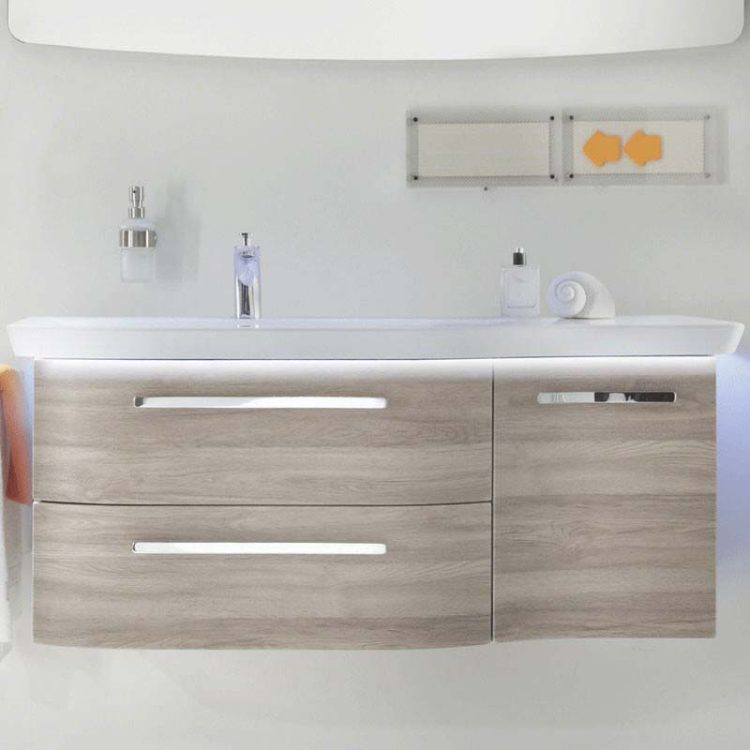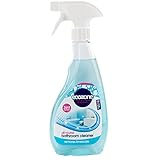Mould is bad for you. That’s official. It triggers breathing problems and can weaken the immune system. It’s also really ugly to look at and can smell awful. Fortunately, mould should be a fairly easy problem to fix, especially if you tackle it in its early stages.
Here’s everything you need to know about getting rid of mould from your home, your bathroom in general and the key areas of your bathroom in particular. We’ll suggest some DIY treatments and the best commercial anti-mould products we’ve found.
Dealing with mould
The very best way to deal with mould is to avoid getting it in the first place. This means you need to understand what it is and what conditions trigger it.
Mould is a fungus. It likes warm, damp conditions, preferably where there is little airflow. Generally, mould will start out as (white) mildew, but, if left unchecked, it will spread and mature to the point where it becomes black mould.
The best way to avoid getting mould is to make sure that there is good ventilation throughout your home. This means that, even if temperatures are kept pleasantly warm (for both humans and mould), the airflow should prevent it from getting a grip. This should be feasible in most areas of the house, but the bathroom may need a little extra help.

How to remove mould from the bathroom
As previously mentioned, the best way to remove mould from the bathroom is to avoid getting it in the first place. This basically means doing everything you can to eliminate condensation. Realistically, the only way you’re likely to succeed with this is to install a self-contained shower cabin. We suspect this is a large part of why they are so popular. If, however, that’s out of your budget for now, then at least do as much as you can to minimize it.
Open a window when you’re having a bath or shower (or at least open it for a short while after you’ve finished). If you have a fan, put that on too.
Deal with any leaking pipes
Try to keep the bathroom as well-insulated as possible (basically you’re trying to stabilize the temperature so you avoid steam touching cold surfaces and condensing).

Equipment you need to remove mould from the bathroom
If you have a serious case of mould, you might want to call in a specialist company. For milder cases (or, frankly, if you don’t have the budget for this), then you need to take appropriate safety precautions. Per adv2ice from the NHS, you want to keep the door closed but the window open and make sure that you have goggles, a mask and gloves. Keep your skin covered as much as possible (obviously wear old clothes).
You will also need plastic bags/containers with an airtight seal to transport anything you need to move to another area of the home (or outside it). For example, if a child’s favourite toy has mould on it and you want to put it in the washing machine, then you need to move it to the kitchen in a sealed plastic container.
DIY mould-cleaning solutions
There are all kinds of DIY mould-cleaning solutions out there, however, these are the only three we think deliver real cleaning power at a reasonable price.
Borax + vinegar + water
Use 1 part borax to 2 parts vinegar and 10 parts warm water. Mix thoroughly.

Borax + baking soda + water
Use 1 part borax to 2 parts baking soda and 1 part warm water. Mix thoroughly into a paste.
For completeness, real boax was banned in the UK in 2010 but there are plenty of substitutes sold under that name (or a very similar one) and they will do the same job.

Bleach + water
Use 1 part bleach to 10 parts warm water. Mix thoroughly (and very carefully).

Baking soda + bleach
Use 3 parts baking soda to 1 part bleach. Mix thoroughly (and very carefully) into a paste.

We strongly advise against using bleach with either borax or vinegar. It won’t get you better cleaning but it may create some major health and safety issues. On that note, when you’re mixing or using bleach, you want the room to be as well-ventilated as possible. If you’re using bleach to treat mould, you’ll need to keep the door closed to contain spores but you should have the window open.
The two liquid solutions are best suited to cleaning mould from flat areas such as tiles, walls, baths and basins. The pastes are best suited to cleaning mould from porous surfaces, for example grout.
For completeness, bleach on its own is highly unlikely to do an effective job of cleaning mould from grout. Its active ingredients will have lost their power long before it gets down to the root of the mould. This means that effectively what you’re doing is adding water, which can make the problem worse!
If you don’t fancy mixing your own DIY mould cleaner(s), we’ve suggested a shop-bought mould cleaner for each task.
How to remove mould from smooth surfaces (e.g. tiles, walls, baths and basins)
This should be a fairly easy win. Spray your cleaner onto the surface and wipe it away with a clean cloth. If you have a lot of mould to clean, you may need several cloths. Forget trying to rinse them, just change them and then either throw them away or hot-wash them before further use. If you have really heavy-duty mould then you may want to use a scrubbing brush. In this case, rinse it with the hottest water you can stand.

Our recommended mould cleaner - Ecozone Bathroom Cleaner Spray
This is mainly sold on its ability to remove limescale, but it also does an impressive job on mould. We have to say we’re not thrilled about the smell and it did catch at our throats a bit. That said, it’s pretty decent compared to the alternatives. It’s also genuinely environmentally-friendly.
How to remove mould from the shower
The night before you intend to clean your shower, remove the shower head, put it in a bag filled with neat vinegar, seal it up tight and leave it at least overnight (the longer the better). Do this even if you don’t see any mould on it.
Start your shower-clean by spraying a liquid solution into your drain. Leave it there while you clean the rest of the shower per the instructions for flat areas. If there is mould on your shower curtains, grout and/or sealant, then check the instructions for cleaning mould from these areas.
When you are finished, put your shower head back and empty the vinegar down your shower drain. Then rinse it out with water.

Our recommended mould cleaner - HG Mould Remover Foam Spray
We’re going to say upfront that this stuff, frankly, stinks of chlorine, so take the guidance about ventilation seriously. We recommend giving the container a good shake before you use it to ensure that you get a foam rather than a liquid spray. Depending on how bad the mould is, results can take anything from seconds to up to 30 minutes. For all its strength, it seems to be safe on paint and coloured tiles.
How to remove mould from shower curtains
At the risk of sounding repetitive, the easiest way to remove mould from shower curtains is to avoid getting it in the first place. In other words, wash your shower curtain regularly. We’d suggest putting it in with your bath towels and adding half a cup (65g) of baking soda to your regular laundry detergent. Stop the cycle before the rinse begins and add half a cup (120ml) of vinegar (preferably white wine vinegar) and then rinse as normal.
This might be enough to clean shower curtains which have mould on them but if not try adding a cup (120ml) of bleach to your wash cycle. For this one you want the shower curtain to be on its own. Again, stop the cycle before the rinse begins and add half a cup (120ml) of vinegar (preferably white wine vinegar) and then rinse as normal.
If that doesn’t work, your last option is to get either the Ecozone Bathroom Cleaner Spray or the HG Mould Remover Foam Spray and treat the mouldy area by hand. Basically, this is a “kill or cure” option so if it doesn’t work, you’ll just have to admit defeat and get a new shower curtain.

How to remove mould from grout
Here’s what you need to understand about cleaning mould from grout. It’s porous. That means it’s absorbent. That means what you need to do to clean mould from grout depends largely on how much it’s sunk into the grout. If it’s just a surface layer then a spray with a liquid cleaner may do the job. This is, however, a bit risky, because liquid cleaners are based on water and water can aggravate mould. You therefore need to make sure to dry the area thoroughly.
If you have a tougher job to tackle, then you need a mould cleaner with less liquid which can be left to sit on the mould and kill it from the roots. Basically you want a weedkiller for your bathroom. If you’re using one of the natural solutions, apply it with a toothbrush (rinse it regularly, preferably with hot water), leave it to sit for about 30 minutes, then wipe it off with a damp cloth and dry thoroughly.
Alternatively, you can try a chemical solution. Our previous recommendation of HG Mould Remover Foam Spray is a solid choice but if you have a really tough job to tackle or you just want to spend the least, possible effort on it, then we’d suggest another option.

Our recommended mould cleaner - Cillit Bang Black Mould Remover
Remember what we said about the HG Mould Remover Foam Spray smelling bad? Well this stuff smells even worse, so please take ventilation seriously. It seems to be safe on paint, tile and plastic but be careful using it around metals, especially chrome. In most cases, you’ll be done in five minutes but if the mould is really bad it can take longer. Realistically, you’d probably be looking at a worst-case of up to 15 minutes, although we’ve heard of people leaving this stuff on for several hours to treat utterly horrendous mould.
How to remove mould from bathroom sealant
In principle, the process removing mould from bathroom sealant is essentially the same as the process for removing mould from grout. In fact, we’d recommend the same products. In practice, it might be quicker and easier just to remove the sealant and replace it with a mould free bathroom sealant.
Best mould-free bathroom sealants

Our top three picks for mould-free bathroom sealants (also known as sanitary silicone) are:
Everbuild SHOWWE C3 Showerproof Bathroom Silicone
Everflex 500 Bath & Sanitary Silicone
UniBond Triple Protection Stop Mould Sealant
In our experience, any of these is a good choice for your bathroom, so just see what’s available at what price when you need it.
Getting rid of mould - in short
The best way to get rid of mould is to avoid getting it in the first place. Effective ventilation is key here. You can also use products with anti-fungal properties and clean your bathroom regularly. In particular, take action at the first sign of mould. The earlier you catch mould, the easier it is to deal with it and the less likely it is that you will need to resort to harsh chemicals.
Even if you’re only dealing with a mild case of mould, remember to use proper safety precautions. The main reason for dealing with mould is that it is bad for your health. You must do everything possible to avoid breathing it in. If you have to resort to harsh chemicals, then you need to treat them with appropriate respect. Make sure you keep the bathroom window fully open (which you should be doing anyway) and protect your eyes and skin.
Content editor, marketer and product tester. A regular contributor for the ‘Home And Garden’ and Modern Homes Magazines, now part of a close-knit team, I oversee all the content on Posh. All roads have led to this job which I love. I get to focus on my love of interior design and health and work with a fabulous team. The role brings me a good level of freedom to my family and me and keeps me productive









![Get Rid of Bathroom & Sealant Mould - [DIY Treatments and Product Guide]](https://posh.co.uk/wp/wp-content/uploads/2020/05/svsv-1-150x150.jpg)







